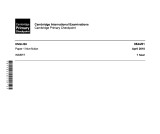|
Download [PDF] October 2018 CAIE P1 Insert 0844 English Cambridge Primary Checkpoint
|
File Information
| Filename: | [PDF] October 2018 CAIE P1 Insert 0844 English Cambridge Primary Checkpoint.pdf |
| Filesize: | 630.66 KB |
| Uploaded: | 31/07/2021 17:45:44 |
| Keywords: | |
| Description: | Download file or read online CAIE Cambridge primary checkpoint past exam paper English 0844/01/INSERT/O/N/18 October/November 2018 insert paper 1 - Cambridge Assessment International Education |
| Downloads: | 46 |
File Preview
Download Urls
Short Page Link
https://www.edufilestorage.com/2Sr
Full Page Link
https://www.edufilestorage.com/2Sr/PDF_October_2018_CAIE_P1_Insert_0844_English_Cambridge_Primary_Checkpoint.pdf
HTML Code
<a href="https://www.edufilestorage.com/2Sr/PDF_October_2018_CAIE_P1_Insert_0844_English_Cambridge_Primary_Checkpoint.pdf" target="_blank" title="Download from eduFileStorage.com"><img src="https://www.edufilestorage.com/cache/plugins/filepreviewer/1063/pdf/150x190_middle_46f4e7862b1eb5bd4935adbbba5d79e8.jpg"/></a>
Forum Code
[url=https://www.edufilestorage.com/2Sr/PDF_October_2018_CAIE_P1_Insert_0844_English_Cambridge_Primary_Checkpoint.pdf][img]https://www.edufilestorage.com/cache/plugins/filepreviewer/1063/pdf/150x190_middle_46f4e7862b1eb5bd4935adbbba5d79e8.jpg[/img][/url]
Related Files | 11
Download file
[PDF] October 2018 CAIE P1 Insert 0844 English Cambridge Primary Checkpoint [PDF]
[PDF] October 2018 CAIE P1 Insert 0844 English Cambridge Primary Checkpoint [PDF]
[PDF] October 2018 CAIE P1 Insert 0844 English Cambridge Primary Checkpoint.pdf | Plain Text
This document consists of 3 printed pages and 1 blank page. IB18 10_0844_01/3RP © UCLES 2018 [Turn over Cambridge International Examinations Cambridge Primary Checkpoint ENGLISH 0844/01 Paper 1 Non-fiction October 2018 INSERT 1 hour
2 © UCLES 2018 0844/01/INSERT/O/N/18 Text A The Aztecs A powerful civilisation in Mexico over 700 years ago What was Aztec family life like? Family life was important to the Aztecs. Within the family, everybody had a role. Husbands generally worked outside the home as farmers, craftsmen or as soldiers. Wives worked at home, weaving cloth for the family’s clothes and cooking. What did Aztec children do? Surprisingly, by law, all Aztec children had to go to school. At that time in history, girls from many other civilisations were not educated. Aztec boys and girls went to separate schools. Boys learned about farming or learned a craft such as pottery or feather-work. They also learned about their religion, and how to fight. Girls were taught about religion too, and how to cook and make clothing. What kinds of homes did Aztecs live in? The wealthiest people lived near the main square in large stone houses. These houses had several rooms and some even had an upstairs. There was a separate room for bathing. Inside the house, the walls were painted in bright colours. Poorer people lived on the edge of the city in simple, undecorated homes made of sun-dried mud. These houses usually had only one big room, which was divided into different areas with no upstairs. What did Aztec people wear? There were astonishingly strict rules about clothing in Aztec society. These rules included laws about the decorations and colours people could wear. For example, only the most important people could wear clothing decorated with feathers, and only the emperor could wear a turquoise-coloured cloak. What was the Aztec diet like? Maize, a food similar to corn, was a staple. The other typical foods were beans and squash. Besides these, Aztecs sometimes ate fish, honey or snake meat. And the cocoa bean, considered highly valuable by the Aztecs, was made into a chocolate drink. 5 10 15 20
3 © UCLES 2018 0844/01/INSERT/O/N/18 Text B Christopher Columbus Christopher Columbus is well-known as an explorer. He was born in Genoa, in Italy, in 1451, but later lived in Portugal, where he was taught how to make maps and pilot a ship. He’s famous for discovering America, although it was already populated of course. However, it was Columbus’s voyage that started the exploration of America by Europeans. Columbus didn’t start out looking for America; it was actually China that appealed to him for its great riches. However, travelling to China on the Silk Road overland from Europe was unsafe, and sailing around Africa to get there took too long. Columbus thought it would be easier to get there by sailing west across the Atlantic Ocean. He believed that China was about 4 000 kilometres from Portugal. He was wrong. It is, in fact, 16 000 kilometres away. However, it would still have been a good plan if only America hadn’t been in the way! Columbus needed money for his voyage. He finally convinced King Ferdinand of Spain to back him, and on August 3, 1492, he set sail. The voyage was long and difficult. At one point, Columbus promised he would turn back in two days if they hadn’t found land. In his journal, however, he wrote that he had no intention of turning back. Then, on October 12, 1492, land was spotted. It was a small island near the coast of America. Columbus called the people there ‘Indians’ because he thought he’d landed in Asia! 5 10 15 20
4 Permission to reproduce items where third-party owned material protected by copyright is included has been sought and cleared where possible. Every reasonable effort has been made by the publisher (UCLES) to trace copyright holders, but if any items requiring clearance have unwittingly been included, the publisher will be pleased to make amends at the earliest possible opportunity. To avoid the issue of disclosure of answer-related information to candidates, all copyright acknowledgements are reproduced online in the Cambridge International Examinations Copyright Acknowledgements Booklet. This is produced for each series of examinations and is freely available to download at www.cie.org.uk after the live examination series. Cambridge International Examinations is part of the Cambridge Assessment Group. Cambridge Assessment is the brand name of University of Cambridge Local Examinations Syndicate (UCLES), which is itself a department of the University of Cambridge. © UCLES 2018 0844/01/INSERT/O/N/18 BLANK PAGE












